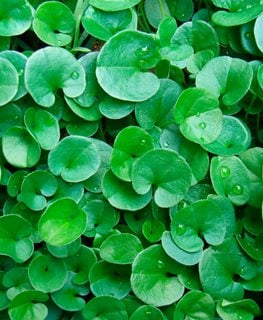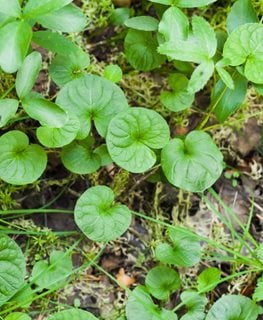HOW TO GROW & CARE FOR DICHONDRA
Use this quick-growing plant as a lawn substitute, to fill in beds and borders, or adorn hanging baskets and containers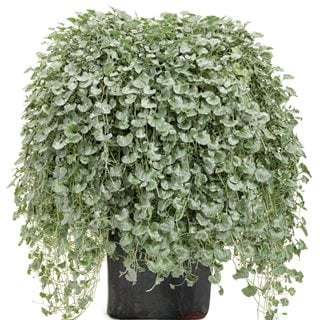
Silver Falls™ dichondra. Photo: Proven Winners
Dichondra is an ornamental perennial with a vining or spreading habit that is grown for the attractive foliage. Native to the Americas, Asia, and Australia, this morning glory relative produces creeping stems and roots easily from the leaf nodes, making it suitable as a quick-growing ground cover.
Because Dichondra has a dense carpet-like appearance and vigorous growth habit, it can be used as a lawn alternative in warmer climates. The cascading habit of Dichondra argentea is versatile in containers and hanging baskets, along rock walls, as edging, or in rock gardens. Here’s how to grow Dichondra and use it in your landscape.
On this page: Basics | Planting | Care | Varieties | Frequently Asked Questions | Landscaping Ideas
On this page:
- BASICS
- HOW TO PLANT DICHONDRA
- DICHONDRA CARE
- DICHONDRA VARIETIES
- FREQUENTLY ASKED QUESTIONS
- DESIGN IDEAS
DICHONDRA BASICS
Botanical name:
Dichondra spp.
Plant type:
Tender perennial, often grown as an annual
Zones:
7-12, depending on the variety
Exposure:
Full sun to partial shade
Habit:
Vining, trailing, or spreading habit. Plants have shallow roots and form a dense mat.
Height/Spread:
2 to 4 inches tall, 3 to 6 feet wide
Bloom time:
Early summer
Flowers:
Small, greenish-yellow or white, star-shaped flowers are insignificant and often hidden beneath the foliage.
Foliage:
Small, 1/2- to 1-inch green or silver leaves are rounded, kidney-shaped, or fan-shaped, with a smooth or scalloped edge.
HOW TO PLANT DICHONDRA
When to plant:
Dichondra can be grown from seeds or starts. Plant in late spring when nighttime temperatures are 50 degrees or warmer and daytime temperatures are in the 70s. In warmer climates, it can also be planted in early fall.
Where to plant:
Choose a site with full sun to partial shade and rich, well-draining soil.
How to plant:
Loosen soil in the planting area and amend with compost or other rich organic matter, if needed. Dig a hole slightly wider and the same depth as the root ball. Remove plant from the nursery container and tease out roots if potbound. Place in the hole so the top of the root ball is level with the surrounding soil. Fill in the hole with soil, tamp down gently and water thoroughly to remove air pockets. Space plants 3 feet or more apart.
Planting from seed:
Press seeds gently into the soil but don’t cover, as they need light to germinate. Keep evenly moist until germination in about two weeks. Thin seedlings to 6 inches apart.
DICHONDRA CARE
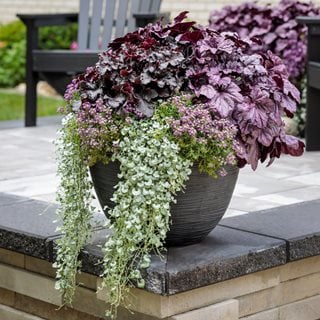
See this container recipe. Photo: Proven Winners
Soil:
Dichondra can tolerate poor soils but performs best in rich, well-draining soil with a neutral pH of 6.5 to 7.5. Avoid planting in clay or other poorly draining soil to prevent root rot. For containers, use a high-quality, all-purpose potting mix.
Amendments & fertilizer:
Dichondra needs little or no supplemental fertilizer. If desired, apply a slow-release all-purpose fertilizer according to instructions in spring when new growth appears. A thin layer of compost can be placed around the base of the plants to provide nutrients, suppress weeds, and retain moisture.
Watering:
Dichondra prefers evenly moist to slightly dry soil. Plants are somewhat drought tolerant once established. Avoid overwatering to prevent fungal diseases or root rot. Container specimens dry out more quickly than those in the ground and will need more frequent watering.
Pruning:
When grown as a ground cover, Dichondra can be mowed to 2 inches high for a neat appearance. Container specimens can be lightly trimmed as needed to retain the desired shape and size.
Pests and diseases:
When given optimal growing conditions, dichondra is more resistant to pests and diseases. Pests include aphids, cutworms, flea beetles, mites, whiteflies, slugs, and snails. Diseases include leaf spot, powdery mildew, pythium blight, root rot, or rust.
DICHONDRA VARIETIES
SILVER FALLS™ —
Dichondra argentea
Zones: 10-12
Habit: Trailing habit
Height/Spread: 2 to 6 inches tall, up to 48 inches long
Bloom time: Early summer
Also known as silver nickel vine or silver ponysfoot, this variety can be found growing natively in parts of the southern U.S., Mexico, Central America, and South America. Grown for the silvery fan-shaped foliage and elegant cascading habit, Silver Falls™ is commonly used for hanging baskets, containers, and as edging. Allow to spill over rock walls or add to a rock garden. Plant in full sun for best coloring.
KIDNEY WEED
Dichondra repens syn. D. micrantha
Zones: 7-11
Habit: Creeping spreading habit
Height/Spread: 2 inches tall, up to 36 inches wide
Bloom time: Summer; flowers are insignificant
Native to Australia and New Zealand, kidney weed is a perennial herb that produces green kidney-shaped leaves on vigorous plants. Also known as lawn leaf, this rapid spreader is useful as a lawn substitute where traditional lawns fail to thrive, though it can only tolerate light foot traffic. It is regarded as a lawn weed in California.
CAROLINA PONYSFOOT
Dichodra carolinensis
Zones: 8-11
Habit: Creeping spreading habit
Height/Spread: 1 to 3 inches tall, 36 inches wide
Bloom time: Summer
Carolina ponysfoot is native to the southeastern U.S., where it can be found growing in moist floodplains and disturbed sites. Plants have green kidney-shaped leaves and a creeping habit. This rapid spreader is useful for quickly covering large areas. The foliage is edible, either raw or cooked, is used as a culinary herb, and can be dried for tea.
FREQUENTLY ASKED QUESTIONS
Is Dichondra deer resistant?
Dichondra is considered deer resistant, though deer may graze on plants if other food sources are scarce.
Is Dichondra poisonous?
Dichondra is considered toxic or mildly toxic (information is mixed) to pets or children. Some mild stomach distress may occur if plants are ingested.
Is Dichondra invasive?
Because Dichondra grows vigorously, it may have invasive qualities in some areas. Keep plants pruned back as needed to control growth.
Is Dichondra a good ground cover?
Dichondra is useful for quickly covering large areas, making it an effective ground cover.
Does Dichondra come back every year?
In USDA zones 10-12, Dichondra can be grown as a perennial. Silver Falls™ is less hardy and is most commonly grown as an annual.
Will Dichondra choke out grass?
Dichondra can establish itself in turf lawns where there are bare spots, and can be difficult to eradicate. Healthy lawns with dense, lush growth are less susceptible.
Can Dichondra survive winter?
Kidney weed and Carolina ponysfoot can overwinter from year to year in milder climates. Silver ponysfoot is grown as an annual in all but the warmest regions.
DICHONDRA LANDSCAPING TIPS
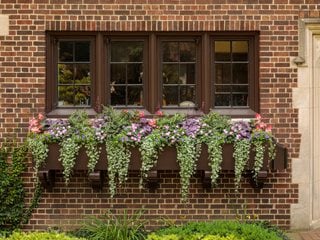
Photo: Proven Winners
For borders and landscapes:
Use as a lawn alternative, in mass plantings, rock gardens, as a ground cover or edging.
For slopes and hillsides:
Sow dichondra seed and allow to naturalize along a slope. Mass plant starts or divide established plants to cover a slope or hillside.
For containers:
Plant in a hanging basket, window box, or container, by itself or in combination with other plants with similar growing needs.
There are many ways to use Dichondra in your landscape. Here’s how:
- Use as a quick growing alternative to a traditional turf lawn.
- Allow to cascade over rock walls to soften the stonework.
- Use silver dichondra as a trailing element in containers, hanging baskets, and window boxes in combination with compatible bushy and upright plants for a “filler, spiller, thriller” effect. (Get container recipes that include Silver Falls.)
- Plant along a pathway or border for lush edging.
- Use a silver-leafed variety to illuminate a moon garden.
Companion plants: With its neutral green or silvery tones, Dichondra pairs well with most other colors. Combine in a container or border with alyssum, angelonia, begonia, coleus, coral bells, fuchsia, lobelia, lantana, calibrachoa, petunia, phlox, salvia or verbena.
RELATED:
Amazing Annuals for Sun
Best Container Plants for Full Sun

